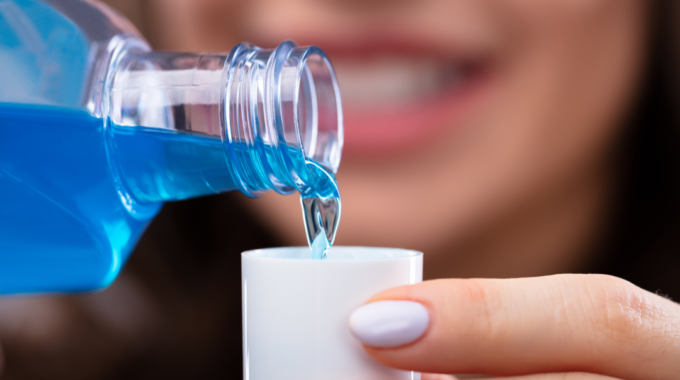When you think about braces, you probably picture straightening teeth and fixing bites, right? But…

Mouthwash: Everything you need to know
A good daily oral hygiene routine is essential for your dental health, and should comprise of:
- Brushing your teeth at least twice a day, using a fluoride toothpaste (preferably with an electric toothbrush), to physically remove plaque from the surface of teeth
- Flossing daily to remove food debris and plaque from in between the teeth
- Cleaning your tongue with a toothbrush or tongue-scraper to remove trapped food debris, which can attract bacteria causing halitosis (bad breath)
But should mouthwash be a part of your mouth care routine too? Let’s find out.
Benefits of mouthwash
People use mouthwash for several reasons, the most common of which include to:
- Freshen breath
- Reduce the risk of tooth decay
- Reduce gum inflammation known as gingivitis
- Prevent gum disease using an antiseptic or anti-plaque ingredient
- Whiten teeth
Types of mouthwash
Mouthwash can be categorized as either cosmetic or therapeutic.
Cosmetic mouthwashes control bad breath or whiten teeth temporarily but have no further chemical or biological benefits and do not kill the bacteria causing bad breath.
Therapeutic mouthwashes have active ingredients to reduce and treat conditions such as bad breath, gum disease, plaque, and tooth decay.
Some examples of therapeutic mouthwashes are:
Antiseptic mouthwashes: Mouthwashes containing Chlorhexidine (0.2 %) are one of the most prescribed antiseptics in oral healthcare. They are effective against bacteria, spores, and fungi within the mouth. They are especially useful where your normal dental hygiene routine has been disrupted, for example, following oral surgery when mouth opening may be limited.
Chlorhexidine mouthwashes are also used in cases of oral ulceration, and in the oral care of patients with learning difficulties or a physical disability who are unable to practice adequate daily oral hygiene. They are also used to manage severe halitosis (bad breath).
These mouthwashes are usually prescribed to be used in 10–15ml doses (often measured in the mouthwash bottle cap) for about 30 seconds, twice daily, for two weeks to one month.
But beware, prolonged use of chlorhexidine mouthwash causes brown staining of the teeth, increased formation of tartar (calculus), temporary alteration to taste (dysgeusia), oral dryness and a sensation of burning of the oral mucosa, which typically resolves when use is discontinued.
Plaque-inhibiting mouthwashes: Plaque-inhibiting mouthwashes have a variety of active ingredients, including antimicrobials, agents to prevent bacteria sticking to tooth surfaces and essential oils.
They are recommended for routine use, ideally twice a day, following thorough brushing and careful interdental cleaning.
Whilst this type of mouthwash often contains alcohol, long-term use of alcohol-based mouthwashes may increase the risk of mouth cancer. As a result, many manufacturers now offer alcohol-free options. Side effects are rare but people suffering from dry mouth (xerostomia), may experience mild dysgeusia and tingling of the inside of the cheeks and lips.
Preventive mouthwashes: Fluoride mouthwash helps rebuild weakened tooth enamel in a process called remineralization, making teeth more resistant to decay and tooth erosion.
Using a fluoride mouthwash ensures that you get the necessary amount of fluoride to help prevent cavities.
There are two main options, daily fluoride rinses (0.05 % sodium fluoride) or weekly rinses of a higher strength (0.2% sodium fluoride). Both reduce dental decay progression in children.
Specialist mouthwash: Specialist mouthwashes, such as Corsodyl and Difflam may prove useful for some patients.
The Difflam Oral Rinse range contains the active ingredient benzydamine hydrochloride which helps to reduce pain and swelling (inflammation) and is a NSADS (non-steroidal anti-inflammatory drug). This product is used to treat conditions like mouth ulcers or discomfort associated with dentures.
Active ingredients used in mouthwashes
There are many active ingredients used in different types of mouthwash, each with its own effects and benefits. They include:
- Cetylpyridinium chloride: Added to mouthwash to reduce bad breath.
- Chlorhexidine: Used to help control plaque and gingivitis, often requires a prescription
- Essential oils (e.g., eucalytol, menthol): Helps control plaque and gingivitis
- Fluoride: Helps prevent tooth decay
- Peroxide: Helps teeth whitening
- Sodium Fluoride: Prevents tooth decay and reduces teeth sensitivity
- Sodium Bicarbonate: Has antiseptic properties and neutralizes acids
- Triclosan: Antibacterial and antifungal properties
- Hydrogen peroxide: For whitening teeth
How to use mouthwash
After brushing with a fluoride toothpaste and flossing, spit any excess toothpaste out. You should avoid rinsing with water or mouthwash straight after brushing, as this will wash away the fluoride from the remaining toothpaste, which helps to prevent tooth decay.
We recommend brushing your teeth a little earlier than normal, waiting around 30 minutes and then using mouthwash just before you go to bed. Alternatively, you could use mouthwash at a separate time to toothbrushing, such as after lunch or when you get home from school. It’s best to avoid eating or drinking for up to 30 minutes after using mouthwash.
In summary, mouthwash shouldn’t replace toothbrushing or flossing. But it can certainly help maintain a happy, healthy mouth, especially if you have braces or attachments which can be hard to clean around.


